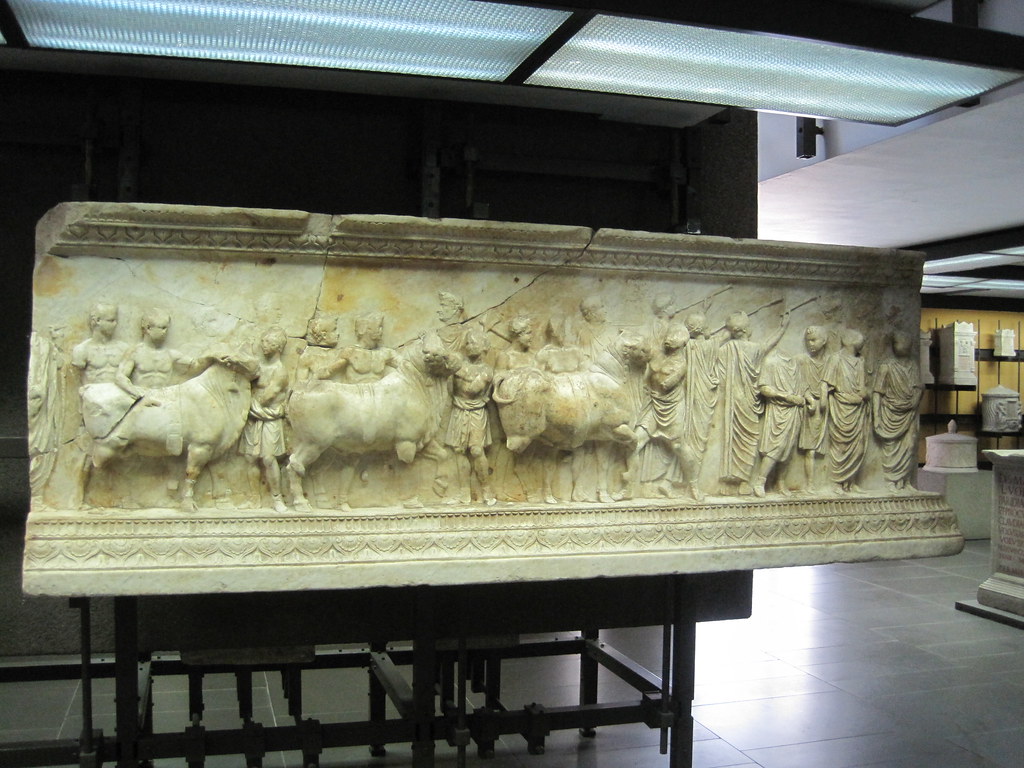View Menu
The (So Called) Vicomagistri Relief
or Smaller Cancelleria Reliefs from the Tiberian/Claudian(?) Period
by Joe Geranio

Right side of the so-called Vicomagistri Relief- Photo courtesy Bill Storage

Front View of Relief Vicomagistri- Photo courtesy of Bill Storage
UPDATE- 2/9/14
With Prof. John Pollini's book that came out in late 2013, "From Republic to Empire: Rhetoric, Religion and Power in the Visual Culture of Ancient Rome. There have been developments in Pollini's and others views that may help with dating and identification or at least the problems that arise with this complex relief from the Julio Claudian period, the "so called" vicomagistri relief. The bottom line is that these altars that belong together were not related to the "Vici" or local or regional magistrates. They were thought to have been part of the local lares altars set up by local districts within Rome from Augustus on. One thing the scholars seem to agree on is they can be broadly dated between the Julio Claudian years of we know as 14 - 68 A.D.
FINDSPOT
I believe as others that the findspot of any such Rome artifacts is crucial, the findspot was as Pollini points our a "sculpture depot and were brought from the original spot where they were found near the Republican tomb of cousul Aulus Hirtius (43 B.C.) (SEE COIN BELOW) to be re-used at some point. For more detailed information on findspot, see: A. Colini, "Notiziaro: Piazza della Cancelleria." BullComm 66: 268-270. See also: F. Magi, " Notiziario: Zona Della Cancelleria". BullCom 67: 205-106.

JULIUS CAESAR. 46 BC. AV Aureus (7.96 gm, 11h). Aulus Hirtius, Praetor. Veiled female head (Vesta?) right / Lituus, jug, and axe. Crawford 466/1; CRI 56; Sydenham 1017. cngcoins.com
A relief from a statue base which depicts the Vicomagistri (freedment magistrates associated with the imperial cult) carrying the Lares and genius of the emperor to a sacrifice. Its style is more crowded and the figures less elegant than the reliefs associated with imperial patronage. Probably dates to the early 20s.1
I am not a great expert, but am a Julio Claudian numismatist first, and almost obsessed with Julio Claudian portraits and reliefs in stone and these are my lay comments for what they are worth. I always ask myself, what do I see in a portrait in the round or a Julio Claudian relief? What is the living message, or in this case; imperial propaganda that was being sent out to the ancient public, since this was a public monument? This relief is such a wonderful work of skilled art that it touches me every time I look at it! There are many great books that speak to the scholarly worth of this piece and I will list some for you to peruse, but this blog is just my personal feeling for the piece.
First, what a wonderful work of Julio Claudian art dated to the A.D. 20ĀĆs or during the reign of the princeps Tiberius (emperor) who ruled from 14-37 A.D. In official state reliefs from Imperial Rome, there are few that remain.2 The Vicomagistri relief (Ara of the vicomagistri) is one of my personal favorites. This relief was found together with Flavian period reliefs from the Cancelleria palace. The procession of the freedman called vicomagistri, were responsible for the Lares Comitales worship from around 7 B.C. forward and also associated with the genius augusti Two of the togated and veiled vicomagistri on the right carry images of the lares and the other to the left carries a togated image of the princeps (emperor).The figures in the front in high relief is more common with public or civic monuments from central Italy; and may by some to be considered unclassical, but its use for the ceremony is practical in this style of Imperial state relief propaganda. Personally I find this relief quite artistic in the high relief of the togated figures in the foreground and the joyful, if not spiritual expressions on the three vicomagistri that are veiled. You can clearly see the low relief rear portraits with the style of the ara pacis.
UPDATED 3/17/14 SEE: http://blog.rome101.com/2014/02/15/the-so-called-vicomagistri-reliefs/
When you have folks from consular rank in the procession that should have been enough to tell us that these were not local or "vici" magistrates? (which Pollini clearly makes a great point regarding social class) The points that the art is inferior by some scholars from other aricles and books makes no sense to me? I find this work absolutely wonderful and one thing all the experts agree on is it is from the Julio Claudian dynasty. After reading all of Polliniís book (a must have for any Republican Ė Julio Claudian junkie, He brings the iconographic, numismatic and especially the literary evidence together to prove his points. but its use for the ceremony is practical in this style of Imperial state relief propaganda. Personally I find this relief quite artistic in the high relief of the togated/ tunic figures in the foreground and the joyful, if not spiritual expressions on the three pueri or so called vicomagistri that are veiled. You can clearly see the low relief rear portraits with the style of the ara pacis. After looking at the physiognomy and bearded figures and most importantly the hairstyle, I see a date of MID Julio Claudian under Caligula, at first look, as where before I thought Tiberian. I wanted to show numismatic evidence of similar style.
References
1. Musei Vaticani, Museo Gregoriano Profano (Vatican City) : Ara dei Vicomagistri
2. Official State Reliefs of the City of Rome in the Imperial Age. A Bibliography by Gerhard Koeppel, Chapel Hill, N. C.
3. Pollini, J. "From Republic to Empire: Rhetoric, Religion and Power in the Visual Culture of Ancient Rome. (2013 University of Oklahoma), pp. 309- 334.











